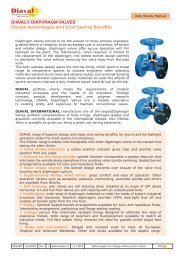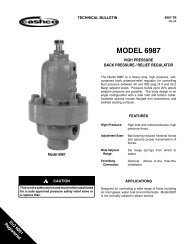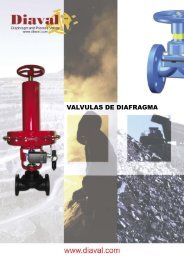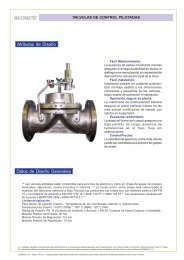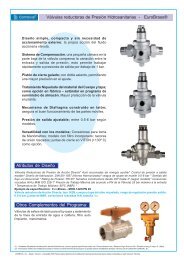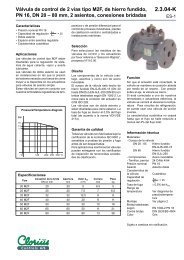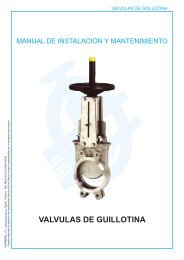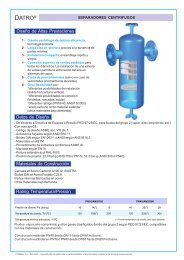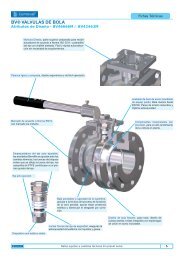Toraflex® - COMEVAL
Toraflex® - COMEVAL
Toraflex® - COMEVAL
You also want an ePaper? Increase the reach of your titles
YUMPU automatically turns print PDFs into web optimized ePapers that Google loves.
Torafl ex® Rubber Expansions JointsEngineering & Performance Data for Toraflex Expansion JointsWorking Parameters-With PTFE sleeve, maximum working pressure is 7 bar.-Check also medium-rubber compatibility .JOINTS10-S15-S20 DN32-200 (1.1/4”-8”)S10-S15-S20 DN200-600 (10”-24”)S30 DN15-80 (1/2”-3”)BURST PRESSURE60 bar40 bar30 barVACUUM APPLICATIONRubber Joints are resistant to negative pressures to a certain extent. They can become wrinkled depending on vacuum suction degree; herewith theguidelines for vacuum applications:JOINTS10 up to DN100S10 DN125-600S15 up to DN300VACUUM LIMIT-0,85 bar-g (0,15 bar-abs) *-0,50 bar-g (0,50 bar-abs) *Full VacuumS20 up to DN600 -0,50 bar-g (0,50 bar-abs) **S30 up to DN80-0,50 bar-g (0,50 bar-abs)* For full vacuum, use embedded specialvacuum ring version** -0,85 bar-g (0,15 bar-abs) with externalvacuum ringPTFE joint is not suitable for vacuum serviceMAXIMUM WORKING PRESSURE FOR S10/15/2025 barSpecial construction + use of PN25 tie rods+ root rings (S20)16 bar+ root rings Special construction + use ofS20PN16 tie rods10 barDN250-300 + root rings (S20)Out of scope- With PTFE sleevemaximum working pressure = 7 bar- For PN16 and PN25 construction itis particularly important to ensure thatpipeline and counterflange are 90º andperpendicular to each other7 barStandard construction- For S20 PN16 DN200-600PN25 DN32-600the use of root ring is highlyrecomended16 bar10 barDN32-DN300 DN350-DN600 DN650-DN1200S30Use root ringNo need for root ring-10ºC50ºC110ºCS30 with root ring integral type7
Torafl ex® Rubber Expansions JointsEngineering & Performance Data for Toraflex Expansion JointsTemperature and Chemical Resistance of Rubber BellowsNBR Butadiene Acrylonitrile (-20ºC) -10ºC ... 75ºC (90ºC)Lubricating oil, cutting oils, fuel oils, animal and vegetable oils, aviation kerosen, LPG, oily air, natural gas.Generally resistant to oils and solvents. Not suitable for steam or hot water. Limited resistance to ozone and wheather.EPDM Ethylene Propylene Diene (-20ºC) -5ºC ... 90ºC (110ºC)Salts in water, diluted acids, alkaline solutions, ester, ketones, alcohols, glycols, hot water, intermittent steam, sterilisationGood resistance to ozone and wheather.It is attacked by hydrocarbon solutions, chlorinated hydrocarbons and other petroleum based oils.Hypalon (CSM) Chlorosulfonated polyethylene (-20ºC) -10ºC ... 80ºC (90ºC)Good chlorine and weather resistance. Resistant to diluted acids and bases. Low resistance to oil and fatsNeoprene (CR) Chloroprene rubber (-20ºC) -10ºC ... 75ºC (90ºC)Good behaviour with water and many oils, and generally with many inorganic and organic products. Nearly tight with hydrocarbongases. Good resistance to weather.Viton (FPM) Vinylidenefluoride-hexafluoro-propyleneco-polymer (-10ºC) -5ºC ... 135ºC (150º)Strong and weak mineral acids, aliphatic hydrocarbons, chlorine gas, oils, aliphatic acids, phosporic acids, ozone, certainaromatic solvents. Not suitable for hot water, steam and dry heat. Not suitable for ketones and chlorine.Butyl (IIR) Isobutene-Isoprene (-20ºC) -10ºC .... 75ºC (90ºC)Dilute mineral acids and alkalies, gases, compressed air (oil free), acidic slurries, chlorine free hydrochloric acid.Resistance to concentrated acids is good with some important exceptions as nitric or sulphuric acids.Good resistance to weather.Natural Rubber (IR) Polyisoprene (-20ºC) -10ºC .... 60ºC (80ºC)Inorganic salt solutions, dilute mineral acids, alkalies and salts. Abrasive services.Not resistant to oxidizing media. Oils and most organic solvents attack it.PTFE/EPDM Virgin PTFE + EPDM (-20ºC) -5ºC ... 90ºC (110ºC)Excellent resistance to chemicals or biopharmaceuticals, strong acids and solvents, alkalies and salts in water.Excellent resistance to weather.Toraflex ® - is a trademark of Comeval Valve SystemsData subject to change without prior noticeBrief Peak TemperatureWorking TemperatureTemperature ranges given just for reference.Pressure-temperature rating and material compatibility also to be considered for rubber selection.Please consult our Technical Department for a particular application.8
Torafl ex® Rubber Expansions JointsEngineering & Performance Data for Toraflex Expansion JointsManufacturing Design Standards and Reaction ForcesManufacture Design Standards- QA certified to EN ISO 9001 procedures.- Testing procedure according to EN12266-1.- Marking according to EN19.- Flanges drilled to EN1092-1 PN10, PN16, or ASME B16.5 ASA150.- Rubber Joints are excluded from the Pressure Equipment Directive PED 97/23/CE, according to its article 1.3-15.Rubber Joints are fl exible components which break the pipe system rigidity. A Rubber Joint acts as a piston by the forcesarising from the internal pressure of the pipe. To prevent the pipes from damage they have to be properly anchored inorder to absorb these reaction forces (Fr).The reaction force caused by internal pressure in a Rubber Joint is calculatedby the following formula:Fr (N) = P (kg/cm 2 ) x A (cm 2 ) x 10Fr =Reaction ForceP = Pressure (Maximum Working Pressure andTesting Pressure must be considered)A = Effective cross sectional areaJoint under pressure acts as a piston.Results shown when working without anchoring.EFFECTIVE AREA VALUESIn rest positionSTYLE S10/S15 S20 S30SIZE DN Effective Area (cm 2 )20 - - 725 - - 1332 21 21 1740 21 21 2550 42 42 3565 59 59 4980 77 85 71100 129 129 -125 193 193 -150 277 277 -200 437 437 -250 692 692 -300 934 934 -350 1086 1110 -400 1445 1492 -450 1847 1839 -500 2306 2222 -600 3286 3337 -Other Reaction Forces:After compressedSTYLE S10/S15 S20 S30SIZE DN Effective Area (cm 2 )20 - - 2025 - - 3132 28 82 3740 28 82 4850 52 119 6265 77 147 8080 97 186 107100 167 269 -125 240 360 -150 333 471 -200 535 702 -250 814 1017 -300 1075 1307 -350 1237 1358 -400 1618 1779 -450 2042 2155 -500 2524 2568 -600 3545 3759 -- Reaction forces caused by the innate joint resistance to move, calculated through the joint stiffness, normally given inN/mm (linear) and Nm (torsion),- Reaction forces caused by the friction of the guides.- Apart from reaction forces caused by the joint installation itself, pipe system weight and centrifugal forces on bendscaused by velocity of the fl uid must also be considered for anchoring.9
Toraflex® Rubber Expansions JointsEngineering & Performance Data for Toraflex Expansion JointsGuidelines to Application - Limit Rods - S10PlateRodRod Sets - S10 for flanges PN10 (Maximum Working Pressure: 10 bar)inchSizemm.M L A B W° ØD ØE R1 R2 F C TNumber of Rod Setsper Joint1-1/2” 40 16 240 37 55 90 18 18 18 20 78 60 10 22” 50 16 250 45 62,5 90 18 18 18 20 88 65 10 22-1/2” 65 16 260 33 72,5 90 18 18 20 20 103 65 10 23” 80 16 280 60 80 45 18 18 20 20 61 50 10 24” 100 16 290 70 90 45 18 18 20 20 69 50 10 25” 125 16 325 85 105 45 18 18 20 20 80 55 10 26” 150 16 340 94 120 45 23 18 22 20 92 60 12 28” 200 20 370 125 147,5 45 23 23 22 24 113 65 12 210” 250 20 440 153 175 30 23 23 22 24 91 65 18 312” 300 20 460 178 200 30 23 23 22 24 104 65 18 314” 350 20 460 208 230 22,5 23 23 22 24 90 60 20 416” 400 20 470 233 257,5 22,5 27 23 25 24 100 60 20 418” 450 20 480 258 282,5 18 27 23 25 24 88 60 20 420” 500 20 480 285 310 18 27 23 25 24 97 60 20 424” 600 24 495 333 362,5 18 30 27 30 28 113 70 20 4Rod Sets - S10 for flanges PN16 (Maximum Working Pressure: 16 bar (DN40-300); 10 bar (DN350-600))SizeNumber of Rod Setsinch mm. M L A B W° ØD ØE R1 R2 F C Tper Joint1-1/2” 40 16 240 37 55 90 18 18 18 20 78 60 10 22” 50 16 250 45 62,5 90 18 18 18 20 88 65 10 22-1/2” 65 16 260 53 72,5 90 18 18 20 20 103 65 10 23” 80 16 280 60 80 45 18 18 20 20 61 50 10 24” 100 16 290 70 90 45 18 18 20 20 69 50 10 25” 125 16 325 85 105 45 18 18 20 20 80 55 10 26” 150 16 340 98 120 45 23 18 22 20 92 60 12 28” 200 20 370 125 147,5 30 23 23 22 24 76 65 12 310” 250 20 440 153 177,5 30 27 23 25 24 92 65 18 312” 300 20 460 180 205 30 27 23 25 24 106 65 18 314” 350 20 460 210 235 22,5 27 23 25 24 92 65 20 416” 400 20 470 233 262,5 22,5 30 23 30 24 102 65 20 418” 450 20 480 263 292,5 18 30 23 30 24 92 65 20 420” 500 20 480 292 325 18 33 23 33 24 102 70 20 424” 600 24 495 348 385 18 37 27 37 28 120 80 22 4Dimensions in mm., subject to manufacturing tolerancesFor higher maximum working pressures please consult us11
Torafl ex® Rubber Expansions JointsEngineering & Performance Data for Toraflex Expansion JointsGuidelines to Application - Limit Rods - S20PlateRodRod Sets - S20 for flanges PN10 (Maximum Working Pressure: 10 bar)Toraflex ® - is a trademark of Comeval Valve SystemsData subject to change without prior noticeinchSizemm.M L A B W° ØD ØE R1 R2 F C TNumber of Rod Setsper Joint1-1/2” 40 16 320 37 55 90 18 18 18 20 78 60 10 22” 50 16 320 45 62,5 90 18 18 18 20 88 65 10 22-1/2” 65 16 320 33 72,5 90 18 18 20 20 103 65 10 23” 80 16 320 60 80 45 18 18 20 20 61 50 10 24” 100 16 380 70 90 45 18 18 20 20 69 50 10 25” 125 16 380 85 105 45 18 18 20 20 80 55 10 26” 150 16 380 94 120 45 23 18 22 20 92 60 12 28” 200 20 515 125 147,5 45 23 23 22 24 113 65 12 210” 250 20 515 153 175 30 23 23 22 24 91 65 18 312” 300 20 515 178 200 30 23 23 22 24 104 65 18 314” 350 20 515 208 230 22,5 23 23 22 24 90 60 20 416” 400 20 560 233 257,5 22,5 27 23 25 24 100 60 20 418” 450 20 560 258 282,5 18 27 23 25 24 88 60 20 420” 500 20 560 285 310 18 27 23 25 24 97 60 20 424” 600 24 600 333 362,5 18 30 27 30 28 113 70 20 4Rod Sets - S20 for flanges PN16 (Maximum Working Pressure: 16 bar (DN40-300); 10 bar (DN350-600))inchSizemm.M L A B W° ØD ØE R1 R2 F C TNumber of Rod Setsper Joint1-1/2” 40 16 320 37 55 90 18 18 18 20 78 60 10 22” 50 16 320 45 62,5 90 18 18 18 20 88 65 10 22-1/2” 65 16 320 53 72,5 90 18 18 20 20 103 65 10 23” 80 16 320 60 80 45 18 18 20 20 61 50 10 24” 100 16 380 70 90 45 18 18 20 20 69 50 10 25” 125 16 380 85 105 45 18 18 20 20 80 55 10 26” 150 16 380 98 120 45 23 18 22 20 92 60 12 28” 200 20 515 125 147,5 30 23 23 22 24 76 65 12 310” 250 20 515 153 177,5 30 27 23 25 24 92 65 18 312” 300 20 515 180 205 30 27 23 25 24 106 65 18 314” 350 20 515 210 235 22,5 27 23 25 24 92 65 20 416” 400 20 560 233 262,5 22,5 30 23 30 24 102 65 20 418” 450 20 560 263 292,5 18 30 23 30 24 92 65 20 420” 500 20 560 292 325 18 33 23 33 24 102 70 20 424” 600 24 600 348 385 18 37 27 37 28 120 80 22 412Dimensions in mm., subject to manufacturing tolerancesFor higher maximum working pressures please consult us
Toraflex® Rubber Expansions JointsEngineering & Performance Data for Toraflex Expansion JointsInstallation LengthEstablishing the building installation length.When all or most of the movement is in one direction, the joint can be installed withbuilding length favouring the absorption in such direction.This can reduce the number of joints needed and thus the number of anchors andguides.Allowed building length range for each Joint type is stated in this manual.Herewith some examples and recommendations for location of Expansion Joints with proper anchoring and guiding.Anchoring and guiding for Joints working as Expansion Joints13
Torafl ex® Rubber Expansions JointsEngineering & Performance Data for Toraflex Expansion JointsAnchoring, Fix Points and GuidingANCHORING. FIX POINTSWe call Fix Points to the anchors that absorb reaction forces.Every Rubber Joint has to be installed between two Fix Points.Fixed point welded for pipes in parallelFixed point for elbowIntermediate Fix Points are the ones just absorbing forces caused by joint stiffness and friction of guides, whereas MainFix Points also absorb the forces caused by internal pressure, centrifugal forces and weights not supported by Guides..Main Fix Points are normally located in pump groups, valves, bends, crosses, line ending or fl ow change sections of thepipe work.GUIDINGGuides not only support the pipe system weight, but also maintain correct alignmentso that the Joints work adequately. It is important to notice that guides supportingthe pipe system are not fi xed points.The Guides should be positioned according to certain rules given further on and theyprevent buckling of the line.Guide with roller standSpecial Guides can be used to allow movement in more than one direction.Installation Guidelines for Rubber Joints absorbing vibration and noiseRubber Joints are commonly installed in pump groups to absorb vibrationand noise.The Rubber Joint must be installed near the pump group, leaving just1-1,5 DN distance. Leave more distance in case of abrassive media.The Pump group frame must be properly anchored to absorb the reactionforces and another fi x point must be set immediately after the rubber jointto limit the vibrations amplitude onto the pipe.Toraflex ® - is a trademark of Comeval Valve SystemsData subject to change without prior noticeProper guiding of the pipe is also necessary to ensure the equipmentworks correctly.Absorbing pipe expansion/compression must be carried out independently.In case Main Fix Points could not be sized to absorb the reaction forcecaused by internal pressure, limit rods can be used to relieve them fromuch forces.14
Torafl ex® Rubber Expansions JointsDouble Sphere Expansion JointsAttributes of Design8 Light and easy to install,little installation space required,easy maintenanceof replaceable bellows.1 Double sphere design allow greateraxial, lateral and angular movementssubject to less effort and material wearingdown during movements.2 Precision injection mouldedof synthetic rubber and nylon.7 - 4 different allowablemovements: axial compressionand expansion,lateral and angular deflection.3 Outer layer protects thebellows surface from eventualozone attack, strikesand other environmental aggressions.Toraflex ® - is a trademark of Comeval Valve SystemsData subject to change without prior notice6 Loose flanges for easyassembly, specially machinedto accept the full turnedrubber, with standard executionin zinc plated steel.5 Full turned rubber design,self-sealing, no additional gasketsare required; it preventselectrolytic corrosion.9 Lot number punched forfull traceability purpose.4 Rugged design with highburst pressure, to absorbnoise and vibration and withstandwater hammers to acertain extent by:-Inner Reinforcement placedin between the outer and innerlayers. Made of Nylon plaitedfabrics as standard, whichprovide high shell mouldingresistance.-End Bellows Reinforcement.Hardened steel wires to providea greater consistence tothe bellows outer neck.10 Rubber material identifi cationand maximum service pressure &temperature.16
Toraflex® Rubber Expansions JointsSingle and Double Sphere Expansion JointsParts and MaterialsS10 / S15S201- Vulcanised Rubber Bellow: 1.1 Rubber core (inner)1.2 Nylon tire cord1.3 Rubber cover (outer)1.4 Hard Steel WireRubber options: EPDM, NBR, Hypalon, Neoprene, Viton, Butyl Rubber,Natural Rubber, PTFE/EPDM2- Loose Flanges:Standard Material: Carbon Steel Zinc Plated S235JR to EN10025(old St 37-2 to DIN 17100)Flange Options: Stainless Steel AISI 304, AISI 316, hot dip galvanized, etc.3- Root ring (option for S20):Standard material: Ductile Iron EN JS1040 according to EN156317
Torafl ex® Rubber Expansions JointsDouble Sphere Expansion Joints with Threaded UnionsAttributes of Design1 Double Sphere design for better strengthand effi ciency allow greater axial, lateral andangular movements subject to less effort andmaterial wearing down during movements.2 Precision injection mouldedof synthetic rubber inserted intounion threads.8 Root ring, compulsory fortemperatures above 50ºC and/or pressures above 10 bar.3 Outer layer protectsthe bellows surface formeventual ozone attack,strikes and other environmentalaggressions.Toraflex ® - is a trademark of Comeval Valve SystemsData subject to change without prior notice5 Light and easy to install, littleinstallation space required, easymaintenance of replaceable bellows,no need for counterfl anges.6 Lot number punched forfull traceability purpose.7 Rubber material identifi cation andmaximum service pressure & temperature.4 Rugged design with high burst pressure,to absorb noise and vibration and withstandwater hammers to a certain extent.18
Toraflex® Rubber Expansions JointsDouble Sphere Expansion Joints with Threaded UnionsParts and Materials1- Vulcanised Rubber Bellow: 1.1 Rubber core (inner)1.2 Nylon tire cord1.3 Rubber cover (outer)Rubber options: EPDM, NBR, Hypalon, Neoprene, Viton, Natural Rubber, Butyl Rubber2- Unions with threaded ends:Standard Material: Malleable Iron Zinc Plated EN-GJMB-350-10 according to EN1562(old GTS 35-10 according to DIN 1692)3- Root ring:Standard Material: Malleable Iron Zinc Plated EN-GJMB-350-10 according to EN1562(old GTS 35-10 according to DIN 1692)19
Toraflex® Rubber Expansions JointsSingle Sphere Expansion Joints - S15Dimensional DetailsPermissible MovementsInitial PositionAxial Compression Axial Expansion Lateral Deflection Angular DeflectionDNInch mm INITIAL(L)BUILDING LENGTH(mm)TOLERANCEINSTALLED(min-max)MAX. MOVEMENTS ALLOWED FROM INITIAL POSITION*AXIALCOMPRESSION(mm)AXIALEXPANSION(mm)LATERALDEFLECTION(mm)ANGULARDEFLECTIONDimensions are expressed in mm, and subjected to manufacturing tolerances. Data can be altered without notice by our Design Department for the product benefi t.ФA(mm)ФC(mm)Approx.Weight (kg)1” 25 130 122-133 30 20 30 35º 60 25 4 41.1/4” 32 130 122-133 30 20 30 35º 68 35 4 41.1/2” 40 130 122-133 30 20 30 35º 68 37 4,5 4,52” 50 130 122-133 30 20 30 35º 86 50 5,5 5,52.1/2” 65 130 122-133 30 20 30 30º 106 65 7 73” 80 130 122-133 30 20 30 30º 118 72 8 84” 100 130 122-133 30 20 30 25º 152 98 9 95” 125 130 122-133 30 20 30 25º 182 122 11 116” 150 130 122-133 30 20 30 15º 213 146 13 138” 200 130 122-133 30 20 30 15º 262 194 19 1910” 250 130 122-133 30 20 30 10º 323 245 24 2712” 300 130 122-133 30 20 30 10º 372 295 29 33PN10PN16/ASA150* The stated movements are solely valid with the joint subject to a single movement direction. Values are proportionally reduced along with the movement combination.* Given tolerance installed and movements allowed are valid for rubber bellows. For bellows with PTFE sleeve, values must be reduced by 1/2.* Increasing temperatures reduce the permissible movements capacity and number of cycles.21
Torafl ex® Rubber Expansions JointsSingle Sphere Expansion Joints - S20Dimensional DetailsPermissible MovementsInitial PositionAxial Compression Axial Expansion Lateral Defl ection Angular DeflectionToraflex ® - is a trademark of Comeval Valve SystemsData subject to change without prior noticeDNInch mm INITIAL(L)BUILDING LENGTH(mm)TOLERANCEINSTALLED(min-max)MAX. MOVEMENTS ALLOWED FROM INITIAL POSITION*AXIALCOMPRESSION(mm)AXIALEXPANSION(mm)LATERALDEFLECTION(mm)ANGULARDEFLECTION1.1/4” 32 175 168-178 50 30 35 40º 68 35 3,5 3,51.1/2” 40 175 168-178 50 30 35 40º 68 37 4 42” 50 175 168-178 50 30 35 40º 86 50 5,5 5,52.1/2” 65 175 168-178 50 30 35 40º 106 65 6 63” 80 175 168-178 50 30 35 40º 118 77 8 84” 100 225 218-228 57 35 40 35º 152 98 9 95” 125 225 218-228 57 35 40 35º 182 122 12 126” 150 225 218-228 57 35 40 35º 213 146 14 148” 200 325 318-328 63 35 45 30º 262 194 20 2110” 250 325 318-328 63 35 45 30º 323 245 26 2912” 300 325 318-328 63 35 45 30º 372 295 32 3514” 350 350 344-353 40 30 30 20º 410 330 42 5016” 400 350 344-353 40 30 30 20º 473 380 54 6718” 450 350 344-353 40 30 30 20º 522 428 62 7720” 500 350 344-353 40 30 30 20º 570 476 77 11924” 600 350 344-353 40 30 30 20º 690 596 82 147Dimensions are expressed in mm, and subjected to manufacturing tolerances. Data can be altered without notice by our Design Department for the product benefi t.* The stated movements are solely valid with the joint subject to a single movement direction. Values are proportionally reduced along with the movement combination.* Increasing temperatures reduce the permissible movements capacity and number of cycles.ФA(mm)ФC(mm)Approx.Weight (kg)PN10PN16/ASA15022
Toraflex® Rubber Expansions JointsDouble Sphere Expansion Joints with Threaded Unions - S30Dimensional DetailsPermissible MovementsInitial PositionAxial Compression Axial Expansion Lateral Defl ection Angular Defl ectionInchDN BUILDING LENGTH (mm) MAX. PERMISSIBLE MOVEMENTS FROM INITIAL POSITION*mmINITIAL(L)TOLERANCEINSTALLED(min-max)AXIALCOMPRESSION(mm)AXIALEXPANSION(mm)LATERALDEFLECTION(mm)ANGULARDEFLECTION¾” 20 200 194-203 22 6 22 45º 17 0,71” 25 200 194-203 22 6 22 45º 25 1,21.1/4” 32 200 194-203 22 6 22 45º 32 1,41.1/2” 40 200 194-203 22 6 22 45º 39 22” 50 200 194-203 22 6 22 45º 47 2,62.1/2” 65 240 234-243 22 6 22 45º 60 3,83” 80 240 234-243 22 6 22 45º 70 5,2Dimensions are expressed in mm, and subjected to manufacturing tolerances. Data can be altered without notice by our Design Department for the product benefi t.ФC(mm)Approx.Weight(kg)* The stated movements are solely valid with the joint subject to a single movement direction. Values are proportionally reduced along with the movement combination.* Increasing temperatures reduce the permissible movements capacity and number of cycles.23
Toraflex® Rubber Expansions JointsS10 - S15 - S20 Flanges Drillingn=4 n=8 n=12 n=16 n=20DNPN10Inch mm ØD ØK n Ød1.1/4” 32 140 100 4 181.1/2” 40 150 110 4 182” 50 165 125 4 182.1/2” 65 185 145 4 183” 80 200 160 8 184” 100 220 180 8 185” 125 250 210 8 186” 150 285 240 8 228” 200 340 295 8 2210” 250 395 350 12 2212” 300 445 400 12 2214” 350 505 460 16 2216” 400 565 515 16 2618” 450 615 565 20 2620” 500 670 620 20 2624” 600 780 725 20 30Toraflex ® - is a trademark of Comeval Valve SystemsData subject to change without prior noticeDNANSI150Inch mm ØD ØK n Ød1.1/4” 32 118 89 4 161.1/2” 40 127 98 4 162” 50 153 121 4 192.1/2” 65 178 140 4 193” 80 191 152 4 194” 100 229 191 8 195” 125 254 216 8 226” 150 279 241 8 228” 200 343 298 8 2210” 250 406 362 12 2512” 300 483 432 12 2514” 350 533 476 12 2916” 400 597 540 16 2918” 450 635 578 16 3220” 500 699 635 20 3224” 600 813 749 20 32DNPN16Inch mm ØD ØK n Ød1.1/4” 32 140 100 4 181.1/2” 40 150 110 4 182” 50 165 125 4 182.1/2” 65 185 145 4 183” 80 200 160 8 184” 100 220 180 8 185” 125 250 210 8 186” 150 285 240 8 228” 200 340 295 12 2210” 250 405 355 12 2612” 300 460 410 12 2614” 350 520 470 16 2616” 400 580 525 16 3018” 450 640 585 20 3020” 500 715 650 20 3324” 600 840 770 20 36Dimensions are expressed in mm, and subject to manufacturing tolerances.24
Toraflex® Rubber Expansions JointsElastomer SelectionThis table is to be used only as a guide in selecting the most satisfactory elastomers for resistance to various chemicals. Because of variables inactual service conditions, the accuracy of the ratings cannot be guaranteed.A = Excellent B = Good C = Conditional X = Not Recommended - = No InformationELASTOMERELASTOMERMEDIANATURAL (NR/IR)NEOPRENE (CR)NITRILE/BUNA-N (NBR)BUTYL (IIR)HYPALON (CSM)EPDMVITON (FPM)MEDIANATURAL (NR/IR)NEOPRENE (CR)NITRILE/BUNA-N (NBR)BUTYL (IIR)HYPALON (CSM)EPDMVITON (FPM)Acetaldehyde C C X A C A X Calcium Acetate B B B A A A XAcetamide C B B A B A B Calcium BisuIfate A A A A A A AAcetic Acid-5% B B C A B A A Calcium Carbonate A A A A A A AAcetic Acid-10% B B C A B A A Calcium Chloride A A A A A A AAcetic Acid-20% B B C B B A C Calcium Hydroxide A A A A B A AAcetic Acid-30% B B C B B A C Calcium Hypochlorite C X C B A A AAcetic Acid-50% C C C B B A C Calcium Nitrate A A A A A A AAcetic Acid-99.5% Glacial C C C B C B C Calcium Oxide A A A A A A -Acetic Acid, Anyhydride C B B B A B X Calcium Sulfate A A A A A A AAcetone B B X A B A X Calcium Sulfide A B A A A A AAcetylene A B A A B A A Carbitol X B B A B B AAir A A A A A A A Carbolic Acid, Phenol X C X B C C AAir.Gas C B A B B C A Castor Oil B A A A A B AAlcohol Absolute A A A A A A B Cellosolve X C C A B A BAluminum Chloride A A A A A A A Chlorinated Solvents (Wet or Dry) X X X X X X AAluminum Hydroxide A A B A B A C Chlorine Dioxide X X X X B C AAluminum Nitrate A A A A A A A Chlorine Gas, Dry C C C C X X BAluminum Sulfate A A A A A A A Chlorine Gas, Wet X X C C X X CAmmonia-Anhydrous (Liquid] A A B A B A C Chlorine Water, 3% B C B X B - AAmmon¡a Gas, Cold A A A A A X A Chlorine Water-Saturated X X C X B C AAmmonia Gas, Hot C B C C C C X Chloro Acetic Acid X X X C B B AAmmonia in Water A A B A B A C Chloro Acetone X C X C B X BAmmonium Chloride A A A A A A A Chloroform X X X X X X AAmmonium Hydroxide B B B A A A A Chlorosulfonic Acid X X X X C X XAmmonium Nitrate A A A A A A A Chromic Acid - to 25 % X X X B A A AAmmonium Phosphate, Monobasic, A A A A A A A Citric Acid A A B A A A ADibasic, Tribasic Cobalt Chloride, 2N A A A A - C AAmmonium Sulfate A A A A A A A Copper Chloride (Cupric Chloride) B A A A B A AAmyl Acetate C X X B X B X Copper Cyanide A B A A B A AAmyl Alcohol A A B A A A A Corn Oil X B A A B A AAniline X C X A C B A Cresylic Acid X X C X C X AAnimal Fats X B A B C A A Cyclo Hexane X X B X X X AArsenic Acid A A B A A A A Cyclo Hexanone X X X C X C XBarium Carbonate A A A A A A A Dichloro Difl uoro Methane (Freon 12) X B B C C B BBarium Chloride A A A A A A A Dichloro Fluoro Methane (Freon 21) X X X C X X XBarium Hydroxide A A A A A A A Diethyl Ether X C B C C X XBarium Sulfate A A A A A A A Diethylene Glycol A A A A A A ABarium Sulfide A A A A A A A Dioctyl Phthalate X X X A X B ABeer A A C A A A A Ethanol A B A A A A BBeet Sugar Liquors A A A A A A A Ethanol Amine B B B A B B CBenzaldehyde X X X B X B X Ethers X X B C B X XBenzene (Benzol) X X C X X X A Ethyl Acetre Acid C C C C B C CBenzyl Alcohol C C X A B C A Ethyl Alcohol (Ethanol) A A A A A A BBenzy I Benzoate X X X A - B A Ethyl Cellúlose B B B A B B ABenzyl Chloride X X X C X X A Ethyl Chloride B B C A B C ABlast Furnace Gas C A C C B B A Ethyl Ether X X B C B X XBorax A A B A A A A Ethylene Bromide X X X X X C BBordeaux Mixture A A A A A A A Ethylene Chloride X X X C X C BBoric Acid A A A A A A A Ethylene Dichloride X X X C X B BBrandy A A A A A A B Ethylene Glycol A A A A A A AButane X B A X A C A Fatty Acids C C B C C X A1-Butene,2-Ethyl X B - X - X A Ferric Chloride A A A A A A AButter X B A A A A A Ferric Nitrate A A A A A A AButyl Acetate X X X B X B X Ferric Sulphate A A A A A A AButyl Acetate Ricinoleate X X X X - - - Fluoro Benzene X X X X X X AButyl Alcohol A A A A A A A Fluosilic Acid A B B A A B AButyl Carbitol X B A A A A A Formaldehyde B B B A A A AButyl Cellosolve X C B A B A C Formic Acid (Formylic Acid) C B C A A B CButyl Ether X B A X C - C Freon 12 X B B C C B BButyric Acid C C C C C C C Fuels-ASTM Ref. Fuel A X A A X X X A25
Toraflex® Rubber Expansions JointsElastomer SelectionA = Excellent B = Good C = Conditional X = Not Recommended - = No InformationELASTOMERELASTOMERToraflex ® - is a trademark of Comeval Valve SystemsData subject to change without prior notice26MEDIANATURAL (NR/IR)NEOPRENE (CR)NITRILE/BUNA-N (NBR)BUTYL (IIR)HYPALON (CSM)EPDMVITON (FPM)MEDIANATURAL (NR/IR)NEOPRENE (CR)NITRILE/BUNA-N (NBR)BUTYL (IIR)Fúels-ASTM Ref. Fuel B X C A X X X A Phosphoric Acid-10% A B A A A A AFuels-ASTM Ref. Fuel C - C - X C X A Phosphoric Acid-20% B B C A A A AFuels-ASTM #1 Oil X B A X B X A Phosphoric Acid-50% C B X B B B AFuels-ASTM #2 Oil X B A X - - - Phosphoric Acid-85% C B X B B B AFuels-ASTM #3 Oil X B A X C X A Picric Acid C C C C A C AFurfural (Furfurol) X C X A C A X Picric Acid-Water Solution A B B A A B AGasoline (Gasolene) X B A X X X A Potassium Acetate B B B A B A BGasoline-40% Aromatic X B B X X X A Potassium Bicarbonate A A A - A - AGasoline-65 Octane X B A X X X A Potassium Bisulfate A A A A A - AGlycerine A A A A A A A Potassium Borate A A A A A A AGlycol A A A A A A A Potassium Carbonate A A A A A A AGrease X B A X C X A Potassium Chlorate A A A A A A AHexane X B A X B X A Potassium Chloride A A A A A A AHexanol A B A B A B B Potassium Hydroxide B B C A A B CHydrochloric Acid-10% A B B A A A A Potassium Nitrate A A A A A A AHydrochloric Acid-25% A C B B A A A Potassium Permanganate A C C A B A AHydrochloric Acid-38% A C C B A B A Propy I Acetate X X X B C C XHydrochloric Acid-50% A X X C B C A Propyl Alcohol (Propanol) A A B A A B AHydro Cyanic Acid B C B B A B A Propylene Dichloride X X X X X X BHydro Fluoric Acid-10% B B B A A A - Rum A A A A A A BHydro Fluoric Acid-50% C C X B A B - Sewage (Sewerage) C A A B A B AHydro Fluoric Acid-65% C C X B A B X Sodium Acetate C B C A A A XHydrofluosilicic Acid A B B A A B A Sodium Bicarbonate (Baking Soda) A A A A A A AHydrogen Gas B A A A A B A Sodium Bisulfite A A A A A A AHydrogen Oxide A C A A A A A Sodium Chloride A A A A A A AHydrogen Peroxide-3% B B B B B B A Soidum Hydroxide A B C A B A BHydrogen Peroxide-10% B C C C B B A Sodium Hypo Chlorite-5% C C C B A B AHydrogen Peroxide-30% C X C C C B A Sodium Hypo Chlorite-20% X X X C A C -Hydrogen Sulfide-Drv , (Cold/Hot} C C X A C A B Sodium Meta-Phosphate A C B A B A AHydrogen Sulfide-Wet, Cold C B C A A A A Sodium Nitrate B B C A A A Alsobutyl Alcohol B B B A A A B Sodium Perborate B B B A B A AIso Octane X B A X B X A Sodium Peroxide B B B A A B AIsopropyl Alcohol A A B A A B A Sodium Phosphate, mono, dibasic, tribasic A B B A A A AIsopropyl Ether X C C X C X CJet Fuels: JP-1, A & A1 X C A X C X A Sodium Sulphate A A A A A A AKerosene (Kerosine) X B A X C X A Sodium Thiosulfate A A A A A A ALactic Acid C B C B A B A Steam - to 225°F C C C B B A XLead Acetate B A B A A A X Stearic Acid X B A B C B ALubricating Oils, SAE 10,20,30,40,50 X B A X C X A Styrene X X X X X X AMagnesium Chloride_ A A A A A A A Sugar Liquors-Cane, Beet & Maple A A A A A A AMercuric Chloride B B A A A A A Sulfur Dioxide C C C B A A AMethyl Acetate X C X B B A X Sulfuric Acid-10% A A B A A A AMethyl Alcohol (Methanol) A A A A A A B Sulfuric Acid-25% B B C B A B AMethyl Bromide C X C B X A A Sulfuric Acid-50% B B C B A B AMethyl Cellosolve X A C A B B X Sulfuric Acid-75% X X X B B C AMethyl Chloride X X X C X C B Sulfuric Acid-95% X X X X C C AMethyl Ethyl Ketone (MEK) X X X B X A X Sulfuric Acid-Fuming X X X X C X BMethyl Formate X B X B C A X Tannic Acid A A C C A C AMethyl Isobutyl Ketone (MIBK) X X X B X B X Tar-Bituminous X C B X C X AMethylene Chloride X X X X X C B Tartaric Acid A C B B A B AMilk B A B A A A A Tertiary Butyl Alcohol A A A A A A BMineral Oils X B A X B X A Tetralin X X X X X X AMono Chloro Benzene X X X X X X A Toluene X X C X X X ANaphthalin X X X X X X A Tributyl Phosphate C X X B C C XNickel Sulfate A A A A A A A Trichloro Ethylene X X X X X X ANitric Acid-10% X B X A A B A Tricresyl Phosphate C C X A C A BNitric Acid-25% X C X B A B A Triethanol Amine (Tea) B B B A A B BNitric Acid-35% X X X C A C A Triethylene Glycol A - A A A - ANitric ACid-50% X X X C B X A Trisodium Phosphate A A A A A A AOleic Acid X C A B B B A Turbine Oil X B B X B X AOlive Oil X B A B B A A Urea A B B A A - -Oxalic Acid B B C A B A C Vaseline X B A X B X AOxygen-Cold B A C A A B A Vegetable Oils X B A A B A AOzone X B X A A A A Vinegar B B C A B A APalm Oil X C A B B - A Vinyl Chloride C X X B X C APentane X B A X C X A Water A B A A A A APerchloric Acid A A X B A B A Water-Drinking A B A A A A APerchloro Ethylene X X X X X X A Water-Seawater/River Water A B B A A A APetroleum-Below 250°F X B A X C X A Whiskey and Wine A A B A A A APhenol X C X B C C A Xylene (Xylol) X X C X X X AHYPALON (CSM)EPDMVITON (FPM)
Torafl ex® Rubber Expansions JointsThe Toraflex Information Data SourceData Sheets ManualComprehensive of all technicaland engineering information onthe comprehensive portfolio.Web Site Product SheetValve description, main dimensions,operating parameters and other linksaccessible at your fi nger tips.Arrangement DrawingsStandardized sectional parts anddimensional drawings for use onengineering projects or enquiries.Join us on the next to startyour Torafl ex® experiencewww.comeval.esPrice ListsUp dated price book comprehensive ofall models including actuated valves.Operating and Maintenance ManualsProvided along every valve into the sealed plasticbag. Also accessible via Internet at all timesOther TORAFLEX products include the range of Metal Bellows Compesators.Contact your Torafl ex distributor for details.27
Moulding the success.Toraflex ®www.comeval.es



